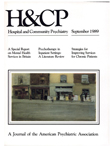Trends in the Rural Community Mental Health Work Force: A Case Study
Abstract
A case study of the community mental health work force in Nebraska over a seven-year period beginning in 1981 examined changes in the professional makeup, overall staffing levels, extent of professional training, and number of medical staff in both metropolitan and nonmetropolitan agencies. The study found significantly more bachelor's -level staff in metropolitan agencies and more master's-level staff in nonmetropolitan agencies. The proportions of doctoral-, master's-, and bachelor's-level staff did not change significantly in metropolitan or nonmetropolitan agencies during the study period. However, beginning in fiscal year 1982, nonmetropolitan agencies had significantly fewer full-time-equivalent positions than metropolitan agencies, and metropolitan agencies experienced significant decreases in medical personnel. The loss of positions in rural agencies portends a crisis in their ability to respond effectively to the needs of rural residents. Special approaches may be needed to facilitate the recruitment and retention of quality mental health professionals in nonmetropolitan areas.
Access content
To read the fulltext, please use one of the options below to sign in or purchase access.- Personal login
- Institutional Login
- Sign in via OpenAthens
- Register for access
-
Please login/register if you wish to pair your device and check access availability.
Not a subscriber?
PsychiatryOnline subscription options offer access to the DSM-5 library, books, journals, CME, and patient resources. This all-in-one virtual library provides psychiatrists and mental health professionals with key resources for diagnosis, treatment, research, and professional development.
Need more help? PsychiatryOnline Customer Service may be reached by emailing [email protected] or by calling 800-368-5777 (in the U.S.) or 703-907-7322 (outside the U.S.).



